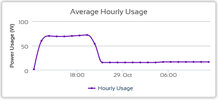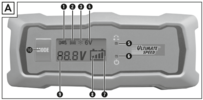I moved house, the result was a few abandoned lead acid batteries, some likely had been flat for a year, also same when caravan in storage when Colvid came.
In the past I would have just dumped the batteries, but thought nothing to lose, so lets try recharging. Two hurdles though, one the smart charger is designed to detect if 6 or 12 volt, and to auto switch off when battery is removed, so some method was needed to kid the charger it was connected to a 12 volt battery, the second is if there is a shorted cell, the charger can over charge the remaining cells.
So I needed a 12 volt 7 Ah battery in parallel with the bad battery to make the charger work, and I also needed an energy monitor so I could see what has happened.
So I used an Energenie energy monitor connected to the PC, so I could see what has gone on, so I would get a graph

showing charge rate, one shown was for a good battery. And I would from time to time have a look to see what had happened.
So the donor battery would charge, and the graph would show zero charge rate in the main, what was happening was the battery voltage would rise to 14.4 volts, then the charger would switch off, and the voltage would drop to 12.7 volt, and the charger would switch on, the time to go from 12.7 to 14.4 and back to 12.8 was very short, and time between 12.8 and 12.7 volt was very long, and it sat there for around 10 days and nothing seemed to happen.
Then it was like flicking a switch, the charger turned on at 0.8 amp and stayed at 0.8 amp for around amp hour rate divided by 0.8. Then it returned to as it was before, except now the faulty battery was fully charged.
This did not just happen with one battery, but with many, I did have some failures, but 80% recharged. It seems keeping a voltage on the battery must slowly soften the sulphur, then it can return to being acid again. This has always been the case, but with flooded batteries we had the option to top up water, so in the 60's with a dynamo we would put batteries on an equalising charge over night once a month, the idea was to over charge good cells so bad cells could catch up, then replace water, but this also ensured any sulphur has time to convert back to acid.
However with the sealed for life battery you can't top it up, so this practice was stopped, and with alternators, it was not really required, but with the modern absorbed glass mat or valve regulated lead acid battery there is even less free acid, should be non, so charging has needed to change as a result, even in the old days we would only recharge over night, but as my experiment showed it can take days not hours to turn all the sulphur back to acid.
My wife's Jag over colvid was not being used, and putting it on charge with the smart charger it would take days before the charger would show zero charge rate, it would raise every day at 12:30 just after midday, clearly some thing in the car was waking up, likely connecting back to Jaguar or wife mobile, she has the option of starting the car before she uses it so warm when she drives off, so it must have some coms.
We have realised if the battery is not seen by the on board computer as fully charged, the stop/start stops working, so if car fails to stop engine at junctions, we know it needs to go on charge for a few days.
We always connect charger to the jump start point under the bonnet, one as easy to leave bonnet cracked open, and two it means the on board computer is registering the charge, we never connect direct to battery in the boot.
The other cars, mine and the tow car for caravan we put on charge around once every couple of months when not in daily use, my car tends to be used once a week to drive 2 miles, this is simply not enough, and I just have to accept it needs a boost every so often.
I use a couple of cheap Lidi chargers.

But not seen them for sale for some time now. The ctek is similar, but much more expensive, and single voltage, the Lidi one also does 6 volt batteries. They are called "Smart" chargers and designed for AGM lead acid and can be left connected to the battery without any harm for months, the old chargers if left connected for an extended time would damage the battery.



